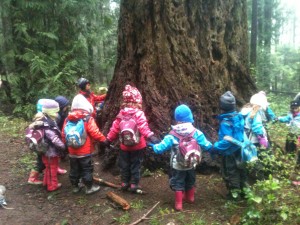 After focusing on creating floor books such as the bird book, Lisa and I (Erin) wondered what other ways the children could demonstrate their learning… so we asked them how they would like to teach others what they know about spring.
After focusing on creating floor books such as the bird book, Lisa and I (Erin) wondered what other ways the children could demonstrate their learning… so we asked them how they would like to teach others what they know about spring.
“We could tell people” a child suggested “Like write it in a letter”.
“We could write a poem or a song” Another thought.
“We could make a poster and read it to everyone”
“We could do a play, like a show”
After brainstorming these ideas, we split into 2 groups and talked about planning techniques and how to work together on the planning stages. The children were given clip boards, pencils and markers and told that they needed to do some planning and idea exchanging so that everyone had a role in the planning and the presentation. The children then split themselves into groups determined by what they wanted to work on. Many children chose to create a play, while some decided to make a poster, write a song, or write a letter to the school.
Lisa and I supported them in through answering questions and encouraging them to work together so that everyone was a part of the effort. After practicing for many days, we wandered around listening to the ideas that were coming from the groups, and I was the practice audience for some of them.
First, I visited two children reading off their clip boards and asked if I could listen in. They agreed and told me where to sit. They both stood up on the log and started to read off their paper, at the same time they began.
“Introducing _______ and ________. What spring is about, by _______________ and ____________.”
Their paper read:
“Spring, Spring, I like Spring,
Spring, Spring, I love Spring.
Spring, Spring Sun
Spring, Spring animals
And bees and tree”.
As I clap one of the children turns to the other and says “we need to practice more I think”. I looked at their page and it is three pieces of paper taped together, with the words to their song written down them.
I move to the next group who are creating a poster about the butterfly life cycle. They have drawn a diagram and labeled it. They have also drawn up “what they are going to say” on separate pages. After they tell me about the life cycle, they tell me that they really want to tell everyone about how our butterflies in the classroom drink Gatorade. (This is True!)
The next group has written out the script to their play and is busy practicing it. It is about bears waking up, eating berries and enjoying the sun. Then out of nowhere a deer appears, it is night time and the owls are out. In case they forget what happens next they have written out the script, and it place it against the tree so they can keep looking at it.
I looked around and notice two children sitting under a Douglas Fir tree, clip boards in hand talking to each other about what they are going to do. I also hear the sounds of the bird group, and look over and see pictures of nest forming.
Another group is a family of bears, waking up from hibernation and another is writing a letter about what they know about spring, it starts: “To Sangster school…” and has mixture of words and pictures.
My favorite part about this is that each child had a role in the planning and production. The children are exploring leadership, collaboration and compromise within this activity. They are using their creativity to think up how THEY want to show their learning. They are planning, and writing what they want to convey. The learning here is in the conversations, not with the teachers but with each other. They are sharing what they know, and creating something from it. They are helping each other to write and spell. We believe that giving the children the opportunity to create their own representation of learning engages them and inspires them. The structure we provided was concepts of planning, creating and presenting and the rest was theirs.
Tomorrow they will present their learning and teach our grade four buddies what they know about spring. What a powerful moment I expect that to be.
(Written by Erin Van Stone, Nature Kindergarten ECE)






